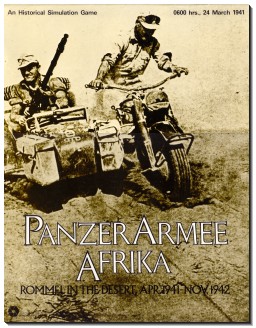
PanzerArmee Afrika, subtitled "Rommel in the Desert, April 1941 - November 1942", is a board wargame published by Simulations Publications, Inc. (SPI) in 1973 that simulates the World War II North African Campaign that pitted the Axis forces commanded by Erwin Rommel against Allied forces. The game was revised and republished in 1984 by Avalon Hill.
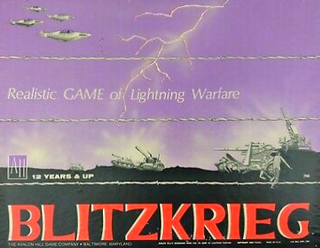
Blitzkrieg is a strategic-level wargame published by Avalon Hill in 1965 that simulates a non-historical attack by one major power against another using blitzkrieg strategy. It was the first commercial wargame that did not simulate an actual historical battle, and with almost 400 counters, it was a precursor of the "monster" wargames of the 1970s featuring more than a thousand counters.

Battle of the Bulge is a board wargame published by Avalon Hill in 1965 that simulates the World War II battle of the same name. General Anthony McAuliffe (ret.), who had been commanding officer at Bastogne during the Battle of the Bulge, was a consultant during the game's development. The game proved popular and sold over 120,000 copies, but was dogged by criticisms of historical inaccuracies, and was finally replaced by a completely new edition in 1981. A third edition in 1991 was released as part of the Smithsonian American History Series.
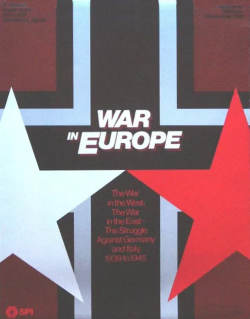
War in Europe is a grand strategic "monster" board wargame published by Simulations Publications Inc. (SPI) in 1976 that attempts to simulate the entirety of World War II's European theater of operations from 1939 to 1945. One of the largest wargames ever produced, War in Europe features 4000 counters, four rulebooks, and nine maps that when placed together cover an area of 38.5 ft2. The game is nominally a three-player game, but each side can be represented by teams of players. SPI estimated the full game would take at least 180 hours.
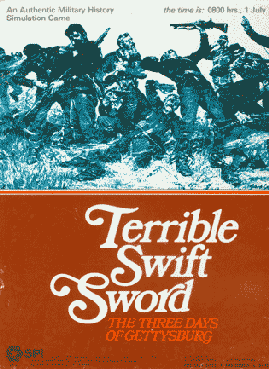
Terrible Swift Sword: Battle of Gettysburg Game is a grand tactical regimental level board wargame published by Simulations Publications, Inc. (SPI) in 1976 that simulates the Battle of Gettysburg during the American Civil War. A second edition was published by TSR in 1986.

Conquistador, originally subtitled "The Age of Exploration: 1495–1600", is a board game published by Simulations Publications, Inc. (SPI) in 1976 that simulates the exploration of the New World in the 16th century. Players take on the role of European countries sending expeditions to find gold and establish colonies. Although the design uses the trappings of board wargames such as a hex map, combat is not a major part of the game.

Armageddon: Tactical Combat, 3000-500 BC is a board wargame first published by Simulations Publications Inc. (SPI) in 1972 in Strategy & Tactics, then released as a stand-alone game, then reimplemented as Chariot: Tactical Warfare in the "Biblical" Age, 3000-500 BC.

Napoleon's Last Battles is a board wargame published by Simulations Publications in 1976 that simulates the last four battles fought by Napoleon. It was one of SPI's most popular games, and also received many positive reviews.
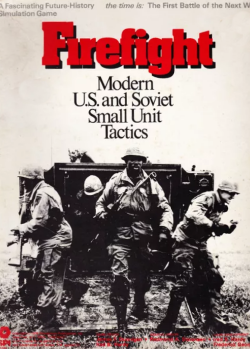
Firefight: Modern U.S. and Soviet Small Unit Tactics is a tactical wargame originally published by Simulations Publications, Inc. (SPI) in 1976 that hypothesizes combat between small units of American and Soviet forces in West Germany in the 1970s.
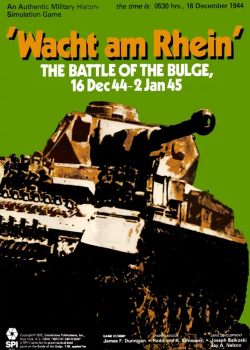
Wacht am Rhein is a grand tactical monster board wargame published by Simulations Publications, Inc. (SPI) in 1977 that simulates Germany's Battle of the Bulge offensive in late 1944 during World War II.

The Battle of Borodino: Napoleon in Russia 1812 is a board wargame published by Simulations Publications Inc. (SPI) in 1972 that is a simulation of the Battle of Borodino during the French invasion of Russia in 1812.

'CA': Tactical Naval Warfare in the Pacific, 1941-45 is a board wargame published by Simulations Publications Inc. (SPI) in 1973 that simulates surface naval battles during the Pacific Campaign of the Second World War.

Frederick the Great, subtitled "The Campaigns of The Soldier King 1756-1759", is a board wargame published by Simulations Publications Inc. (SPI) in 1975 that simulates several of the campaigns of Frederick the Great in Central Europe during the Seven Years' War. When SPI ran into financial difficulties, they sold the rights to the game to Avalon Hill, who produced a second edition in 1982.

Fulda Gap, subtitled "The First Battle of the Next War", is a board wargame published by Simulations Publications Inc. (SPI) in 1977 that simulates a hypothetical attack by Warsaw Pact forces against NATO defenders in West Germany using technology and tactics of the mid-1970s

Global War, subtitled "The War Against Germany and Japan, 1939–45", is a grand strategic and economic board wargame published by Simulations Publications Inc. (SPI) in 1975 that simulates the entire extent of World War II.

Kursk: Operation Zitadelle is a board wargame published by Simulations Publications Inc. (SPI) in 1971. It was the first wargame to simulate the Battle of Kursk, the large tank battle during World War II.

MechWar '77, subtitled "Tactical Armored Combat in the 1970s", is a board wargame published by Simulations Publications Inc. (SPI) in 1975 that simulates hypothetical tank combat in the mid-1970s between various adversaries, using the same rules system as the previously published Panzer '44.

The Moscow Campaign, subtitled "Strike and Counterstrike Russia", is a board wargame published by Simulations Publications Inc. (SPI) in 1972 that simulates combat near Moscow during World War II.

1918, subtitled "Operation Michel: March 21–30, Germany's Last Chance in the West", is a board wargame published by Simulations Publications Inc. (SPI) in 1970 that simulates Operation Michael, the final German offensive on the Western Front in which they tried to win the war or at least force peace talks before American soldiers started to arrive on the Western Front in force. The game was well received by critics, but did not sell well.

Breitenfeld, subtitled "Triumph of the Swedish System", is a board wargame published by Simulations Publications Inc. (SPI) in 1976 that simulates the 1642 Battle of Breitenfeld during the Thirty Years' War. Breitenfeld was a free game that appeared in Strategy & Tactics, designed to promote SPI's soon-to-be-launched wargame Thirty Years War. Breitenfeld proved popular and was also published as part of SPI's "folio" series of games.




















